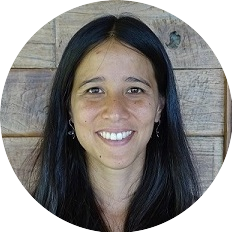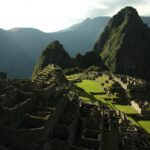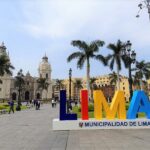If you are traveling to Peru and would like to witness one of the typical celebrations and festivals in Peru, your chances are high.
Peru celebrates almost 7000 traditional festivals every year, so there’s always something going on. Some celebrations are multitudinary, like El Señor de los Milagros procession in Lima. Even very small villages have their own unique celebrations and traditions. Generally, the more remote the village, the more unique its festival becomes.
As you willl see in the following list, the majority of celebrations and festivals in Peru have religious roots. But while in many cases they honor a Catholic saint, the celebrations reflect a unique mix of Christian beliefs and the native cosmovision of the universe, where Mother Earth and the Mountain deities hold an equally revered place as Jesus and the Virgin Mary.
Let’s take a look at what are the best celebrations and traditional festivals in Peru throughout the year.
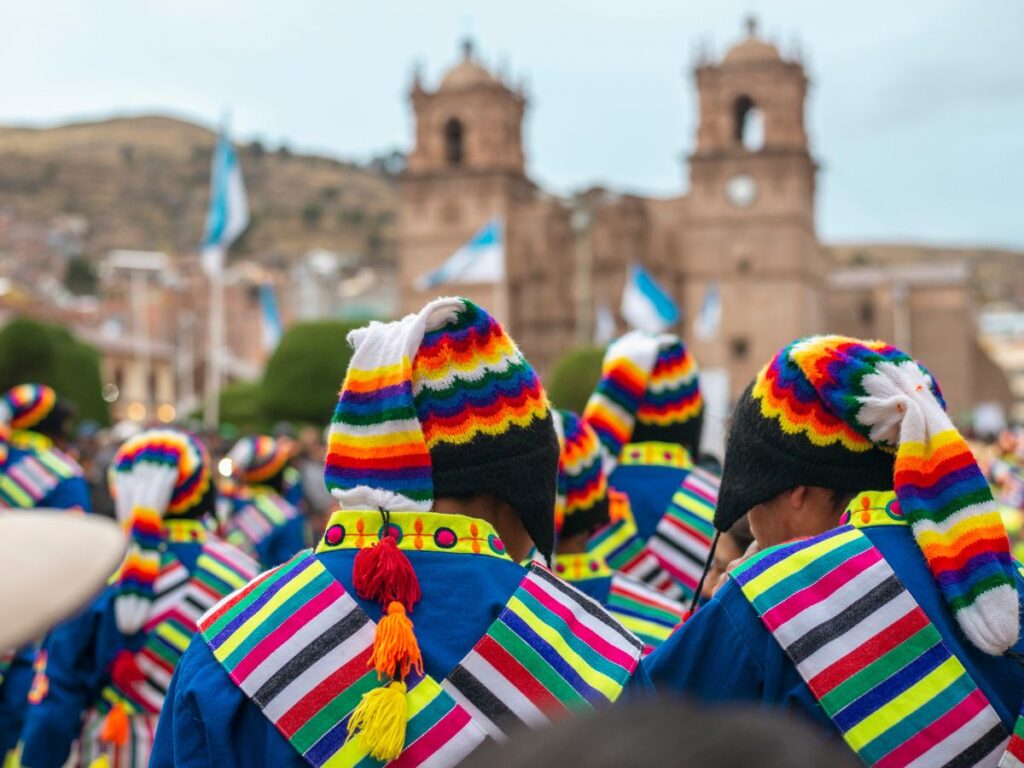
Festivals in Peru in January
January 6th: Bajada de Reyes (Three Kings’ Day)
This is a Catholic festival celebrating the arrival of the three kings to visit Jesus. It marks the time of the year when traditionally people will put away their Christmas tree and nativity.
In cities like Lima or Arequipa, you can see three policemen dressed up as the three kings. They go around the main square giving sweets to children.
In many smaller towns and rural areas around Peru, though, you may encounter much bigger celebrations for the Bajada de Reyes.
For example, in Ollantaytambo, in Cusco, they have a big celebration involving typical dances and processions, with people joining from different nearby communities. There, the celebrations will go on until the 8th.
Other regions where travelers can witness cheerful and colorful celebrations for the Bajada de Reyes include Apurímac, Huancavelica and Huánuco.
January 20th: Qashwa de San Sebastian
Qashwa de San Sebastian in Juliaca
The Qashwa de San Sebastian festival in Juliaca is a vibrant cultural festivity in Juliaca, Puno.
At the heart of the festival are the energetic qashwa dancers who wear dazzling, intricately embroidered costumes and masks. These dancers, often in large groups, perform lively traditional choreographed routines accompanied by traditional Andean music.
The dance groups traverse the main streets, inviting the residents to participate in the ascent of Huayna Roque hill. At the hill, they will do an offering to the Earth, or Pachamama, usually consisting of gifting coca leaves, drinks and flowers among other presents to the Earth.
If you are going to visit Puno and will get there by plane, you will land at Juliaca airport, so it can be the perfect ocassion to join the celebrations.
This festivity takes both in Puno cit and place on one of the most beautiful islands in lake Titicaca: Amantani. In recent years, this island has become a popular destination for travelers visiting Puno, who often stay for the night at a homesday sharing the daily life of the locals.
January 20: Qashwa de San Sebastian in Amantani
A similar festivity is also held at Amantani, an island in lake Titicaca, though to a smaller scale.
During this festivity, the villagers celebrate an offering to both Pachatata (Father Earth) and Pachamama (Mother Earth).
Offerings to the Earth are a prevalent custom across the entire Andes region. However, in this particular ceremony, the local residents are making a special request for a prosperous year ahead.
The event takes place in a day full of music and traditional dances.
Festivals in Peru in February
Fiesta de la Virgen de la Candelaria (Festivity of the Virgin of the Candelaria)
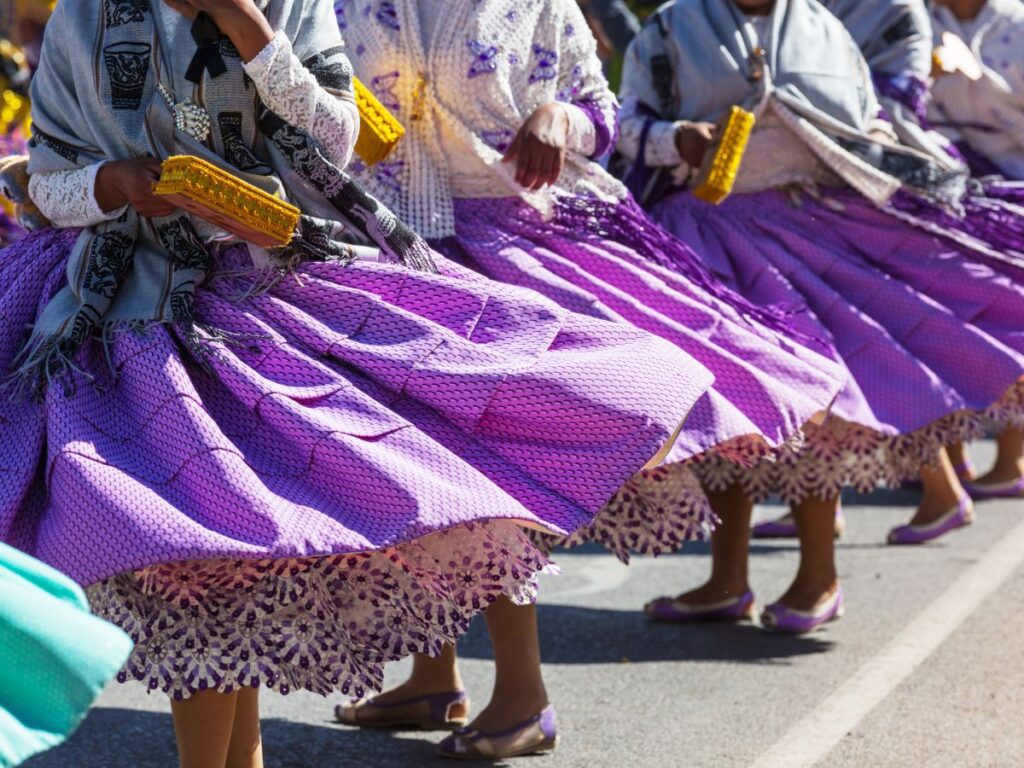
One of the biggest and most colorful festivities in Peru takes place the first two weeks of February in Puno. The festivity celebrates the Virgin of la Candelaria, amidst a unique blend of indigenous traditions and Catholic rituals. It’s a festivity of colorful costumes, intricate masks, and dynamic dance competitions.
The streets of Puno become alive with dances from all over Puno during those weeks, and become the central part of the festivity.
Thousands of dancers embark on a journey from their villages to partake in the region’s most significant event of the year. they It’s a captivating convergence of communities, each contributing its unique dance.
The diablada, a dance portraying the eternal struggle between good and evil, takes center stage. It’s an iconic example of the fusion of pre-Columbian Andean and Spanish colonial influences.

When visiting Peru in February, be sure to include Puno and Lake Titicaca in your itinerary! A stroll through the streets of Puno during these days will create unforgettable memories. Personally, I think attending this festival is on the top of things to do in Puno.
Unfortunately, the celebrations have been on hold since the pandemic. They were also cancelled in 2023 due to social protests in the region. The regional authorities are working towards, hopefully, making the celebration happen again in 2024.
Festivals in Peru in March
First Week of March: Grape Harvest Festival
The Festival de la Vendimia, or Grape Harvest Festival is the main event in March in Ica, on the coast of Peru. Ica is the main producer of grapes in the country, with which they produce wine, and pisco, the Peruvian national drink.
The main event of the festival is a big main parade and the election of the Queen of the Festival. Accompanied by her maids, the Queen and her court stomp the first grapes of the season.
The celebrations continue for several days, and they include concerts, fireworks, dance competitions, and food and crafts fairs where you can get nice Peruvian souvenirs.
And if you are into extreme sports, don’t miss the sandboarding competitions at the nearby Huacachina oasis (you can also go sandboarding yourself, which is one of the top things to do in Huacachina).
On the last night, the yunza takes place, a dance in which couples go around a tree decorated with sweets, gifts and ornaments. Then, with the ax that the men carry on their shoulders, they try to cut the trunk. The couple that manages to make the tree fall is the winner. They will be the best treated during the party and will be in charge of organizing the next festival.
Easter: Semana Santa
Depending on the year, Easter falls in March or in April. You can read about the Easter celebrations under Events in Peru in April.
Festivals in Peru in April
Easter: Semana Santa
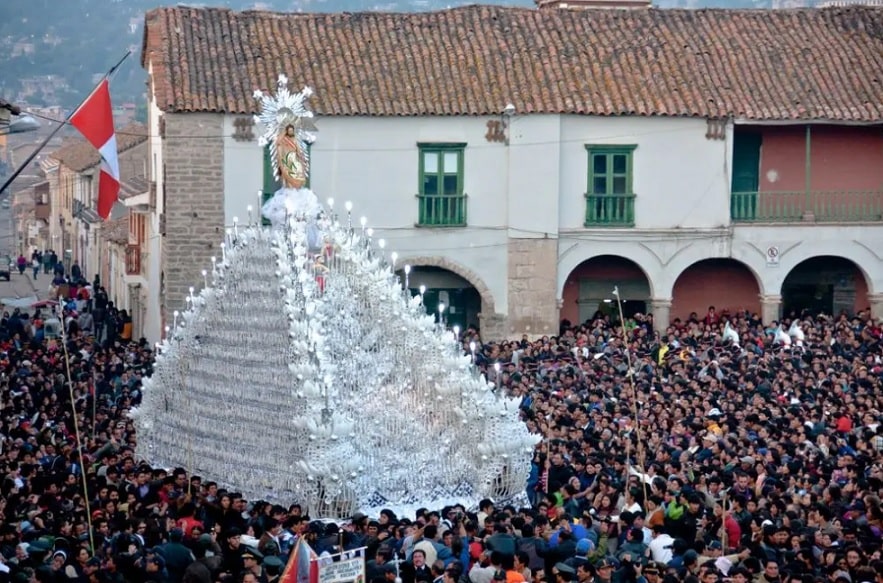
While Easter is celebrated everywhere in Peru, the heart of this festive occasion is Ayacucho, in central Peru. In fact, Ayacucho is home to the second biggest Easter festivities in the world (only after the ones in Sevilla, Spain)!
Not only the locals fill the streets in breathtaking processions, but people from all over the country travel to Ayacucho during those days as well. It’s an ideal time to visit the city, adorned with beautiful flower carpets covering the streets.
The main Easter tradition is to visit 7 churches on Holy Thursday. The churches all around the city will be alive with most locals doing the same. You will not have any problem trying to get to the next church, though. Ayacucho, even though a small city, is home to 33 churches that date back to colonial times.
Festivals in Peru in May
End of May or Beginning of June: Qoyllur Rit’i
Qoyllur Rit’i is an ancient religious celebration that takes place every year in the Sinakara Valley, Cusco, and attracts thousands of visitors. It is held at the end of May or the beginning of June, coinciding with the full Moon. The exact date varies each year but is not later than the first week of June.
Qoyllur Rit’i means “snow star”, and it refers to the Pleiades constellation, which appears in the sky at that time of the year. Traditionally, the time when it appears, is considered the beginning of the harvest season in the Andes.
However, this festival does not have pure Andean roots, but is a mix of ancient traditions and Christian beliefs. The festival actually revolves around an image Christ that people believe appeared in the mountain.
While the whole festival takes four days, the main event is a 1-day pilgrimage to the site of the Christ image.
Visitors will find a vast variety of cultural expressions every day. The place becomes alive with colors, aromas, sounds, and the rhythm of dance.
The central day of the event is when the Ukukus, anthropomorphically disguised characters, ascend to the summit of the mountain to perform a ceremony of gratitude.
Festivals in Peru in June
June 23rd and 24th: Fiesta de San Juan (St. John)
San Juan (Saint John) is the patron saint of the Peruvian Amazon, so as you can imagine, the San Juan festival is the most anticipated celebration in the area.
The majority of the population, prepare for the celebrations weeks ot months before. They make sure to have all the ingredients to prepare juanes, a typical and iconic dish of the region, and chicha de jora, a typical Peruvian drink.
One of the best places to witness this Peruvian festival is in Iquitos. Already several days before the central celebrations, travelers can enjoy the gastronomic fais, typical dances and parades through Iquitos and its districts.
The main celebrations take place on the night of June 23rd, when many people bathe and purify themselves in the rivers of the Amazon jungle. There is a deeply rooted belief that Saint John blesses the water currents that day. Whoever bathes in them will enjoy health and happiness throughout the year.
Bonfires called shuntos are also lit as purification rituals. According to tradition, they attract happiness to homes and help face the new stage of the year with God’s favor. Many make wishes by jumping over the fire, especially couples in love who jump together to swear eternal love.
On the 24th, the celebrations continue with a procession, parades, dance and music.
June 24th: Inti Raymi
The best time to visit Cusco is in June, not only because it’s the dry season in Peru and the skies are clear, but because you can withness the Inti Raymi, the Inca Festival of the Sun.
This celebration is hundreds of years old, and pays homage to the Sun God, the Inti, who was the main deity of the Incas.
The main event takes place at the historic Sacsayhuamán fortress, where participants, dressed in colorful Inca attire, reenact ancient ceremonies. It’s a powerful spectacle of traditional rituals and ceremonies.
In addition to the central ceremony the entire city of Cusco comes alive with festivities. The atmosphere is filled with music, dance, and spiritual energy, providing a strong cultural immersive experience.
It’s a journey back in time, allowing you to connect with the rich heritage of the Inca civilization.
Festivals in Peru in July
July 15-18: Virgen del Carmen de Paucartambo Festival
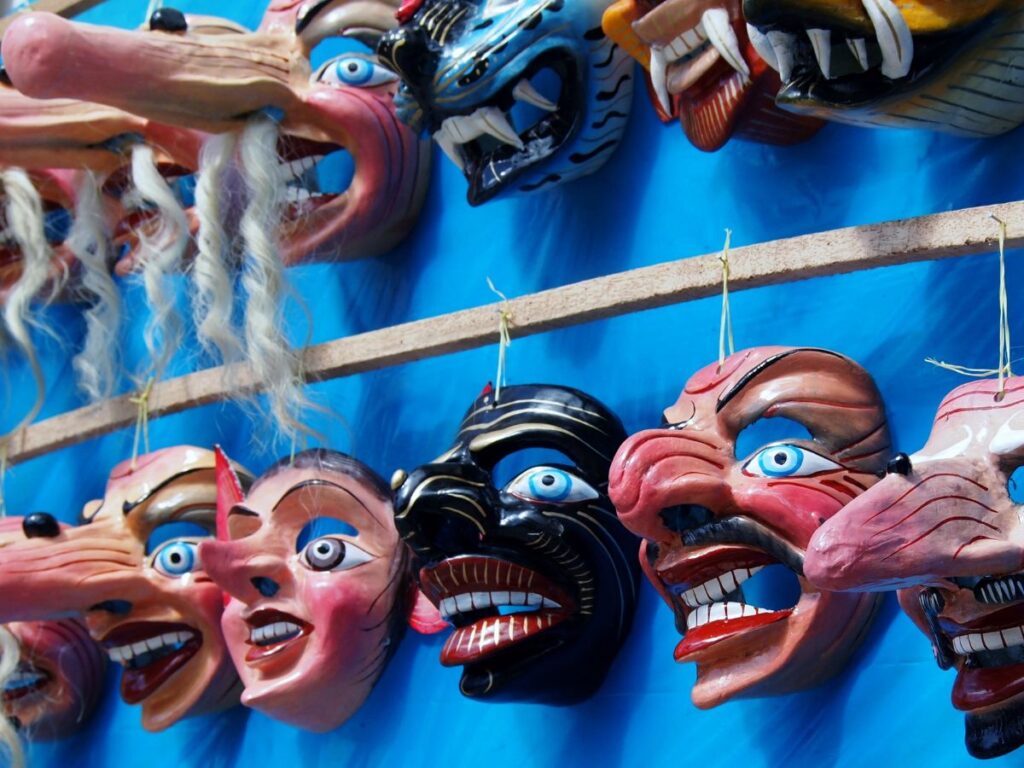
Even though his festival is celebrated in various regions, the most famous one is in Paucartambo, in the Cusco region. This is a very significant cultural event, full of colors and dance, and a favorite of travelers both from Peru and abroad.
This festival uniquely blends indigenous and Catholic traditions. The festival’s central part is the procession of the Virgin through the town’s streets. Participants wear intricate and colorful costumes, representing historical and mythological figures.
During the days that the festival lasts, the event that stands out the most is possibly the “guerrilla”. This guerrilla, or “small war”, is a representation of angels and demons, where participants engage in vibrant street performances, reenacting epic battles between celestial and infernal forces.
Paucartambo is just two hours away from Cusco city, so if you will be in Cusco in July, make sure to include this in your itinerary. If you are going from Cusco to the Manu National Park, Paucartambo is also a great stop to break down the trip.
Last Days of July: Vilcas Raymi
A visit to Vilcashuamán and its majestic Inca ruins is one of the top things to do in Ayacucho. And even more so if you visit in July, when one of the most important festivities in Ayacucho is celebrated: Vilcas Raymi.
This colorful celebration conmemorates the times of the Inca Empire and the battle between the Incas and the Chancas, the people who lived in the area before they were conquered by the Incas.
The main event is the staging of the battle between the Inca and Chanka armies and the coronation of the victorious Inca. It all takes place at the Incan ruins site, which is at the heart of the town. There’s also the Atipanakuy, or competition of scissor dancers, possibly the most spectacular Peruvian dance.
Aditionnally, travelers can also witness the rituals of payment to the Mother Earth (Pachamama) and the Mountain Gods (the Apus). These are ceremonies that are carried out in gratitude for the production of agricultural fields.
July 28th and 29th: Fiestas Patrias (Independence Day)
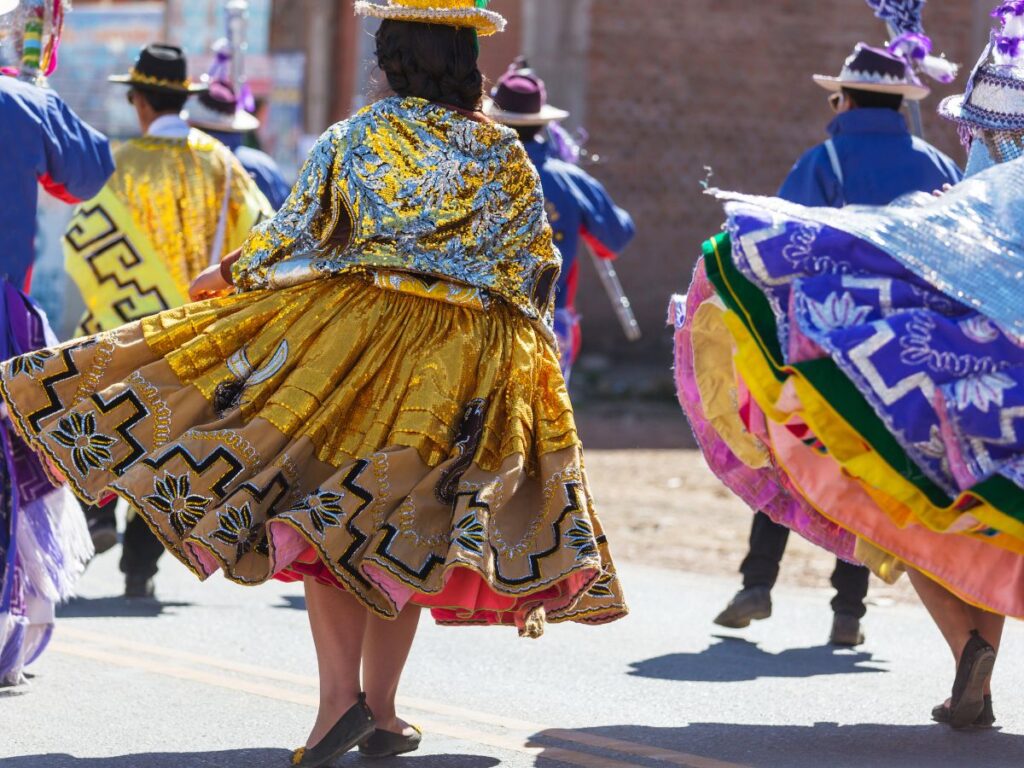
Fiestas Patrias is one of the most significant nationwide celebrations in Peru. These days commemorate Peru’s independence from Spanish rule, around 200 years ago.
Travelers visiting during this time can expect a lively atmosphere brimming with patriotic fervor. In general, the streets are full of people enjoying their days off and having fun, so expect some crowds and higher airfares around these dates. Especially because Peruvians get paid a double salary on July because of Fiestas Patrias.
The main cities come alive with colorful parades. For example, in Cusco, you can see traditional dances and captivating cultural displays around the main square.
In Lima, there are not interesting parades from a touristic perspective (the main event is a military parade), but you you will likely find fairs of traditional food from all over Peru in different areas. The festivities culminate with a spectacular display of fireworks in Miraflores, painting the night sky in vibrant colors and creating a festive ambiance.
Festivals in Peru in August
August 30th: Santa Rosa de Lima
Santa Rosa de Lima was the first Catholic saint of the Americas, and to commemorate her, the 30th of August is a holiday in Peru.
While many Peruvians will make use of this long holiday to do domestic tourism, many others will attend the religious procession in Lima center. The most religious ones, will visit the Santa Rosa Sanctuary and leave her a letter in the well of wishes, where a miracle was supposed to have taken place some centuries ago.
Nowadays, there’s even a Whatsapp number where people can send their letters to Santa Rosa if they can’t go to the well.
Festivals in Peru in September
Last Days of September/First Days of October: Spring Festival
The Spring Festival is the main festival in Trujillo, a city in northern Peru famous for its archaeological sites and the nearby Huanchaco beach town.
Trujillo is actually nicknamed “the city of the everlasting spring” because of its good year-round weather. Between the last days of September and the first days of October, several events of music and dance take place around the city.
The main attraction of the festival is a parade, which involves a competition for the best spring-themed decoration. Other important events are the contest of the Peruvian Paso horses and the coronation of the Spring Beauty Queen.
Festivals in Peru in October
Lord of the Miracles (El Señor de los Milagros)
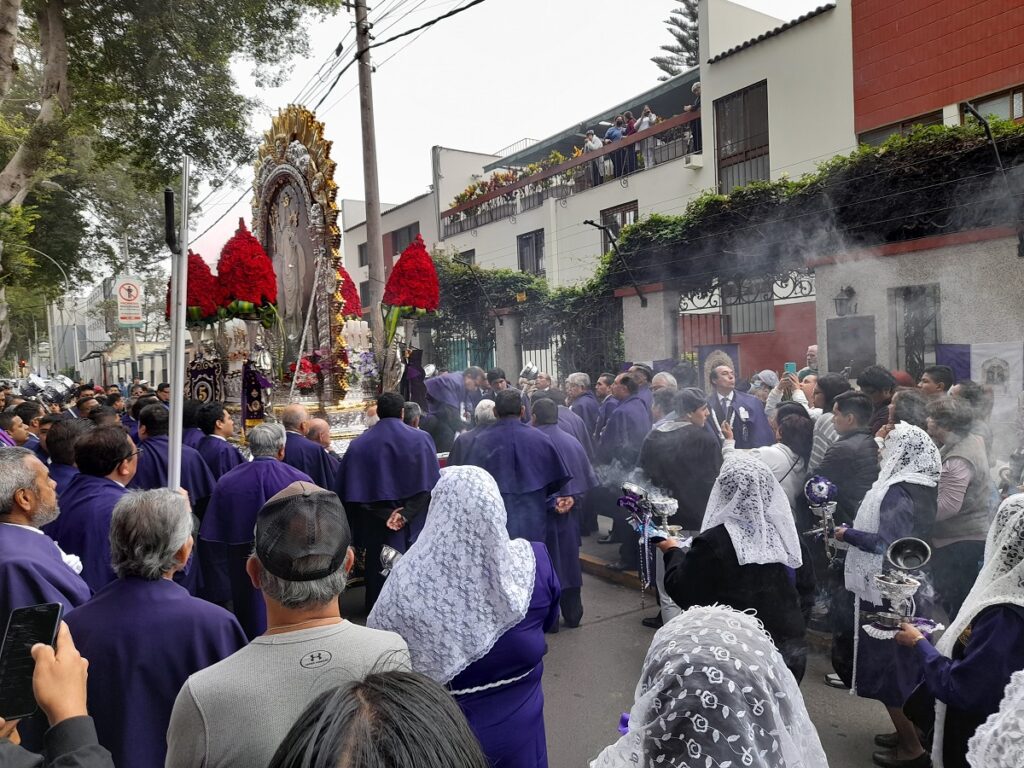
Discover why a good time to visit Lima might just be in October, during the vibrant Lord of the Miracles procession, one of the largest religious processions in South America.
This is the procession of the Lord of the Miracles, a revered image of Christ that is the patron of Lima. Around a million devotees, dressed in purple, accompany this image every October along the streets of Lima center, creating a walking sea of purple.
Actually, throughout the whole month you will see many ladies wearing a purple robe in Lima, as a tribute to the Lord of the Miracles (you can read about that and about what clothes to bring for your trip in this post about what to wear in Lima).
The procession typically takes place on the 8th, 18th, 19th and 29th of October. If you want to take part of this powerful experience, those are the dates to visit Lima center.
But if you aren’t into crowds, avoid those dates. Also, the traffic to and from the center will be extremely heavy.
You might also have the opportunity to witness smaller processions in other parts of the city during October. Even though small, they are a spectacle in themselves. For example, the picture above was taken in the neighborhood of Barranco.
Besides Lima, the Lord of the Miraflores celebrations take place all throughout Peru.
Festivals in Peru in November
November 1st: Dia de Todos Los Santos (All Saints’ Day)
Dia de Todos Los Santos is a day to pay homage to deceased loved ones and to remember and honor the saints.
In a way, this day has a similarity to Dia de Los Muertos in Mexico, though the celebrations are not as big; they are mainly a private celebration. There are no parades in the streets, but the events take place at the cemeteries.
Catholic families often visit cemeteries to clean and decorate the graves of their relatives, leaving offerings of flowers, candles, and food. The atmosphere is one of respect and remembrance, and it is a meaningful cultural experience for travelers who wish to understand Peruvian traditions related to life, death, and spirituality.
Depending on the region, there can be different traditions related to this day. For example, in Cajamarca, they will place the foods, sweets, fruits, and liquor on a table, which the deceased person used to like.
This table is set up in a room of the house just minutes before midnight on November 1st to 2nd, at which time souls are belived to visit the Earth. Relatives light up candles and place a cross there, and no one enters the room until the second day.
A big cemetery in Lima that you could visit on that day is El Ángel, in a neighborhood called El Agustino.
Festivals in Peru in December
December 8th: Virgen de la Inmaculada Concepción
The celebration of the Virgen de la Inmaculada Concepción, the Virgin of the Immaculate Conception, is observed in various cities and towns across Peru.
While the main day of the festivity is on the 8th, depending on the place, the celebrations can start a few days before and last for a couple of days after.
Among the places where the festivities hold particular importance are Arequipa, Puno and Cusco. In each place, it will be celebrated according to their own local traditions.
In Chivay (Arequipa), for example, the celebration begins on the 6th, when the altar caretakers start decorating the altars. Later that night, the they enter the houses of devotees, and playfully take them out of their beds for the traditional dance that starts in the middle of the night.
On the central day, December 8th, the procession goes all around the town. Finally, on the 9th they hold a traditional dance competition.
December 24th and 25th: Christmas
Christmas is celebrated by the great majority of Peruvians all over Peru. Like in most places, it’s mainly a family celebration.
The main celebration takes place on Christmas Eve, on the 24th of Dember. Families will get together to have dinner together, usually at big gatherings where the extended family will be present. Dinner is usually had at midnight, and there are fireworks all over.
If you are traveling to Peru during Christmas, take into acount that almost all restaurants will be closed on Christmas Eve. Your best option will be to have dinner at your hotel.
On the 25th, the streets will be full of families going out for a walk enjoying the summer. Though not all restaurants will be open, you will still have plenty of options of places to eat out.
If you are curious about facts and local traditions, you can read this post about Christmas in Peru.
Before You Go…
As you can see, from the Inti Raymi in Cusco in honor to the Sun God, to the Lord of the Miracles in Lima celebrating Jesus, festivals in Peru reflect the deeply mixed identity of the country.
The culture and traditions of Peru are so rich, that you would need to spend enough time both at bigger cities like Lima and Arequipa as much as in more unusual destinations in Peru to grasp a better understanding of them.
If you are still on the beginning stages of planning your trip to Peru, I invite you to read my recommended Peru itineraries: three weeks in Peru, 10 days in Peru, 5 days in Cusco and Lima itineraries.
